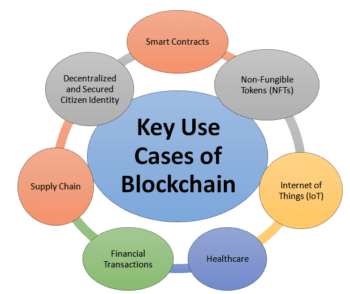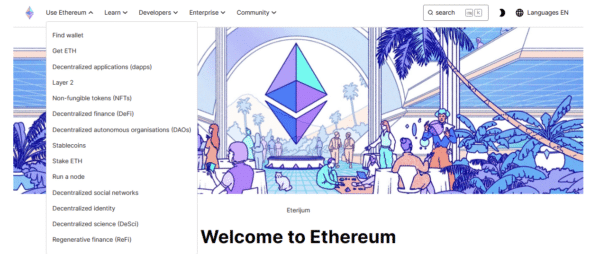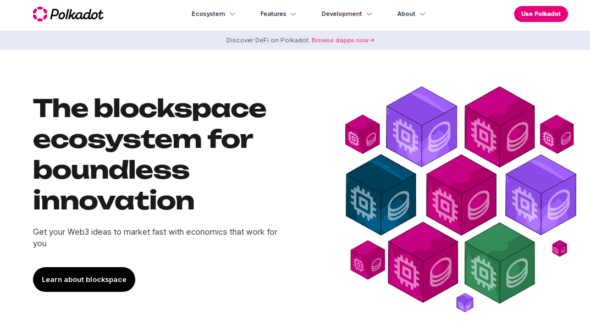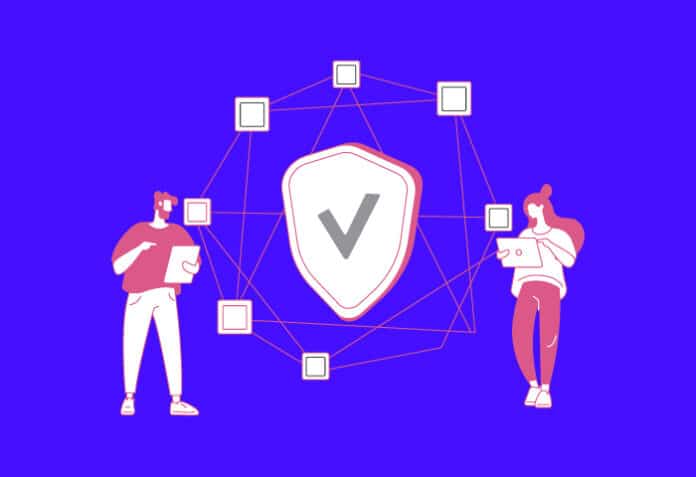Smart contracts and decentralised applications are helping revamp finance and supply chains, as well as improve healthcare services. Let’s dive into the cutting-edge programming platforms that help them do this.
Blockchain technology has revolutionised the conduct of transactions by establishing a decentralised and secure framework. Blockchain serves as the underlying technology for decentralised systems, offering transparency, immutability, and security. Initially known for its association with cryptocurrencies like Bitcoin, blockchain technology has evolved to find applications across diverse industries. The distributed ledger system ensures all network participants access the same information, eliminating intermediaries and reducing fraud risks.

At its core, blockchain is a decentralised and distributed ledger that ensures secure and transparent record-keeping. Its primary use case was cryptocurrencies, notably Bitcoin, providing a transparent and tamper-proof method of conducting financial transactions. Beyond finance, blockchain has found applications in supply chain management, where its decentralised nature enhances traceability and reduces fraud. In healthcare, it facilitates secure and interoperable sharing of patient data, improving the efficiency of healthcare systems. Blockchain’s potential extends to voting systems, intellectual property protection, and more, showcasing its versatility in fostering trust, transparency, and efficiency in diverse sectors.
A significant innovation in blockchain technology is the creation of self-executing agreements referred to as smart contracts, which are directly encoded into the system.
Smart contracts and decentralised applications (dApps)
Smart contracts are self-executing programs with predefined rules and conditions, deployed on a blockchain. These contracts automate and enforce the terms of agreements, cutting out the need for intermediaries and reducing the risk of errors or fraud. Decentralised applications, or dApps, are software applications that operate on a decentralised network of computers. Smart contracts are integral to the functionality of many dApps, providing a trustless and efficient way to execute code securely.
Decentralised applications leverage the decentralised nature of blockchain to provide users with transparent, secure, and censorship-resistant experiences. These applications operate on a peer-to-peer network, ensuring that data remains tamper-proof and resilient to single points of failure. As the adoption of smart contracts and dApps continues to grow, their transformative impact on traditional business models becomes increasingly evident, ushering in a new era of decentralised and trustless interactions.
Programming platforms for the development of smart contracts and dApps
The development of smart contracts and dApps relies heavily on sophisticated programming platforms. These platforms serve as the foundation for crafting secure, efficient, and decentralised solutions.

As the blockchain ecosystem expands, a diverse array of programming platforms has surfaced, each contributing to the evolution of smart contract and dApp development methodologies.
Ethereum
URL: ethereum.org
Ethereum is a pioneer in smart contract platforms and remains a dominant force in the space. Developers can use the Ethereum Virtual Machine (EVM) to deploy smart contracts written in languages like Solidity. Born out of the vision of Vitalik Buterin, Ethereum has introduced a versatile blockchain that extends beyond the limitations of Bitcoin, allowing developers to create complex dApps and execute smart contracts. Ethereum’s blockchain serves as a decentralised and secure global computer, enabling a myriad of use cases across various industries. One notable application lies in the financial sector, where it facilitates the creation of decentralised finance (DeFi) platforms, offering services such as lending, borrowing, and decentralised exchanges. Additionally, it finds applications in supply chain management, healthcare, and identity verification, bringing transparency, security, and efficiency to traditional processes. Its open source nature has fostered a vibrant community of developers continuously innovating and expanding the platform’s capabilities, making Ethereum a cornerstone in the evolution of blockchain technology.
Binance Smart Chain
URL: binance.org
Binance Smart Chain (BSC) is a blockchain network compatible with the Ethereum Virtual Machine. It offers fast and low-cost transactions, making it an attractive option for developers. The platform supports various programming languages, providing flexibility in smart contract development. Offering a range of use cases, it is particularly renowned for the Binance Smart Chain (BSC), which facilitates the development of decentralised applications and the execution of smart contracts. BSC has gained widespread adoption due to its compatibility with the Ethereum Virtual Machine (EVM), enabling developers to seamlessly migrate and deploy existing Ethereum-based projects on Binance Smart Chain. Moreover, Binance blockchain has carved a niche in the realm of decentralised finance (DeFi), providing a secure and efficient environment for various financial services, including token swaps, lending, and yield farming. Its low transaction fees and high throughput contribute to an ecosystem that appeals to developers and users alike, fostering innovation and accessibility within the blockchain space.
Polkadot
URL: polkadot.network
Polkadot is a multi-chain network that facilitates interoperability between blockchains. Developers can create custom blockchains, including those tailored for smart contracts, using the Substrate framework. Its unique design allows different blockchains to communicate and share information securely. Founded by Dr Gavin Wood, one of the co-founders of Ethereum, Polkadot introduces a unique multi-chain architecture that facilitates interoperability between multiple blockchains. Unlike traditional blockchains, it supports the seamless transfer of data and assets across various chains, fostering a more interconnected and scalable ecosystem. This interoperability feature has broad implications, enhancing communication and collaboration between different blockchain networks. Polkadot’s relay chain and parachain structure enable greater flexibility in designing customised blockchains, each tailored to specific use cases. Use cases for Polkadot span a wide range of industries, including finance, supply chain, healthcare, and more. By addressing the challenges of scalability, interoperability, and customisation, Polkadot is playing a pivotal role in advancing the capabilities of decentralised applications and the broader blockchain ecosystem.
Cardano
URL: cardano.org
Cardano is a blockchain platform that aims to provide a more secure and scalable infrastructure for the development of smart contracts and decentralised applications. It uses the Haskell programming language for smart contract development. Launched with a research-driven methodology, Cardano distinguishes itself by incorporating academic peer-reviewed research into its development process. The platform operates on a layered architecture, separating the settlement and computation layers, aiming to enhance scalability and flexibility. Cardano’s native cryptocurrency, ADA, facilitates secure and transparent transactions within its ecosystem. With a focus on sustainability, interoperability, and regulatory compliance, Cardano seeks to address challenges prevalent in the blockchain space. The use cases for Cardano span a variety of sectors, including finance, identity verification, supply chain management, and governmental services. Its commitment to academic rigour and a comprehensive development strategy positions Cardano as a promising player in the blockchain realm.

NEO
URL: neo.org
NEO is a blockchain platform that supports smart contracts. Developers can use languages like C#, Java, and Python for creating smart contracts on the NEO platform. Founded with the vision of establishing a more scalable and user-friendly blockchain ecosystem, NEO supports multiple programming languages, including C#, Java, and Python, making it accessible to a broad range of developers. One of NEO’s key strengths lies in its ability to facilitate the creation of decentralised applications (dApps) and smart contracts in a highly efficient and secure manner. NEO’s use cases extend across various industries, from finance to supply chain management, where its advanced features, such as a Byzantine fault-tolerant consensus mechanism and a unique delegated Byzantine Fault Tolerance (dBFT) consensus algorithm, contribute to the platform’s reliability and robustness.
Avalanche
URL: avalabs.org
Avalanche supports the creation of interoperable and highly scalable applications. Recognised for its unique consensus protocol called Avalanche Consensus, the platform distinguishes itself by providing high-throughput, near-instant transaction finality, and robust security. Avalanche stands out as a leader in the blockchain space due to its ability to support custom blockchain networks and facilitate the creation of decentralised applications (dApps). The platform’s flexibility, scalability, and interoperability contribute to its growing popularity among developers and enterprises.
Tezos
URL: tezos.com
Tezos is a self-amending blockchain platform that supports smart contracts and decentralised applications. It utilises the Michelson programming language for smart contract development.
Algorand
URL: algorand.com
Algorand is a blockchain platform that focuses on high-performance and decentralised applications. It uses a unique consensus algorithm called Algorand Consensus.
Tron
URL: tron.network
Tron is a blockchain platform known for its emphasis on content and entertainment applications. It supports the creation of decentralised applications and smart contracts.
EOS
URL: eos.io
EOS is a blockchain platform that aims to provide a user-friendly environment for building decentralised applications. It uses a delegated proof-of-stake consensus mechanism.
Exploring these platforms allows developers to choose the one that best aligns with their project requirements, programming preferences, and scalability needs. The blockchain landscape continues to evolve, and each platform contributes to the diversity and innovation within the decentralised application development space.
The scope for research and development in smart contract programming is vast. New platforms are emerging, each with its unique features and advantages. Researchers can explore areas such as scalability, privacy, and sustainability within smart contract platforms. Interoperability between different blockchain networks is another exciting avenue for development. By contributing to the open source community, developers can shape the future of decentralised applications and smart contract programming.




